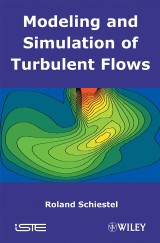Details

Modeling and Simulation of Turbulent Flows
, Band 4 1. Aufl.
|
290,99 € |
|
| Verlag: | Wiley |
| Format: | |
| Veröffentl.: | 05.01.2010 |
| ISBN/EAN: | 9780470393468 |
| Sprache: | englisch |
| Anzahl Seiten: | 750 |
DRM-geschütztes eBook, Sie benötigen z.B. Adobe Digital Editions und eine Adobe ID zum Lesen.
Beschreibungen
This title provides the fundamental bases for developing turbulence models on rational grounds. The main different methods of approach are considered, ranging from statistical modelling at various degrees of complexity to numerical simulations of turbulence. Each of these various methods has its own specific performances and limitations, which appear to be complementary rather than competitive. After a discussion of the basic concepts, mathematical tools and methods for closure, the book considers second order closure models. Emphasis is placed upon this approach because it embodies potentials for clarifying numerous problems in turbulent shear flows. Simpler, generally older models are then presented as simplified versions of the more general second order models. The influence of extra physical parameters is also considered. Finally, the book concludes by examining large Eddy numerical simulations methods. <p>Given the book’s comprehensive coverage, those involved in the theoretical or practical study of turbulence problems in fluids will find this a useful and informative read.</p>
Chapter 1. Fundamentals of statistical modelling: basic physical concepts. <p>Chapter 2. Turbulence transport equations for an incompressible fluid.</p> <p>Chapter 3. Mathematical tools.</p> <p>Chapter 4. Methodology for one point closures.</p> <p>Chapter 5. Homogenous anisotropic turbulence.</p> <p>Chapter 6. Modelling of the Reynolds stress evolution equations.</p> <p>Chapter 7. Turbulence scales.</p> <p>Chapter 8. Advanced closures: new directions in second order modeling.</p> <p>Chapter 9. Modeling the turbulent flux evolution equations for a passive<br /> scalar.</p> <p>Chapter 10. The passive scalar variance and its dissipation rate.</p> <p>Chapter 11. Simplified closures: two and three transport equation models.</p> <p>Chapter 12. Simplified closures: zero and one transport equation models.</p> <p>Chapter 13. Treatment of low Reynolds number turbulence.</p> <p>Chapter 14. Wall treatment: methods and problems.</p> <p>Chapter 15. Influence of Archimedean forces.</p> <p>Chapter 16. Notes on the problems posed by the study of complex flows.</p> <p>Chapter 17. Variable density turbulent flows.</p> <p>Chapter 18. Multiple scale models.</p> <p>Chapter 19. Large Eddy simulations.</p> <p>Chapter 20. Synopsis on numerical methods.</p>
<b>Roland Schiestel</b> got his Doctorate (Es Physical Sciences) from the University of Nancy (France) in 1974 and has also an engineer degree of the “E.N.S.E.M.” in Nancy in 1971. Research director at the “Centre National de la Recherche Scientifique” (C.N.R.S.) in France, he is currently active in research at the “Institut de Recherche sur les Phénomènes Hors Équilibre” (I.R.P.H.E.) in Marseille.
This title provides the fundamental bases for developing turbulence models on rational grounds. The main different methods of approach are considered, ranging from statistical modelling at various degrees of complexity to numerical simulations of turbulence. Each of these various methods has its own specific performances and limitations, which appear to be complementary rather than competitive. After a discussion of the basic concepts, mathematical tools and methods for closure, the book considers second order closure models. Emphasis is placed upon this approach because it embodies potentials for clarifying numerous problems in turbulent shear flows. Simpler, generally older models are then presented as simplified versions of the more general second order models. The influence of extra physical parameters is also considered. Finally, the book concludes by examining large Eddy numerical simulations methods. <p>Given the book’s comprehensive coverage, those involved in the theoretical or practical study of turbulence problems in fluids will find this a useful and informative read.</p>


















